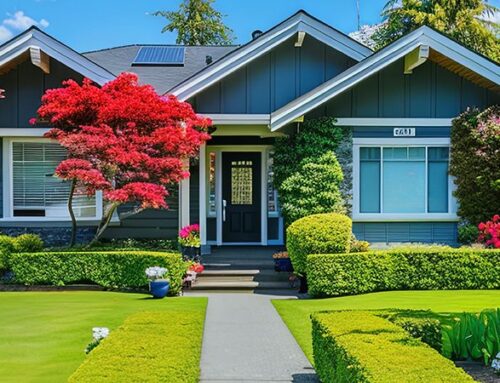This is the time of year when you look outside at your dry husk of a lawn and think, “I should really do something about that.” It’s been so hot in Nevada County that the last thing on your mind has been maintaining your lawn. You were more focused on keeping cool. But before you go running out to set up a sprinkler system the size of Niagara Falls, you should really consider your lawn’s eco footprint. Thirsty lawns suck down somewhere between 30 to 60 percent of the world’s urban freshwater, amounting to hundreds of thousands of gallons a day. Even unwatered lawns take their toll. Lawn mowers, trimmers, and other outdoor equipment dump out a staggering 242 million tons of pollutants each year, amounting to about 4 percent of the world’s annual CO2 emissions. And enterprising homeowners who manage their own lawn care wind up spilling about 17 million gallons of gasoline a year, which is about 6 million more gallons than spilled by Exxon Valdez. Lawns also damage natural ecosystems as well. Synthetic pesticides and fertilizers used in the backyard wind up in streams and waterways as runoff. The nitrogen in such pollution in turn causes algae to proliferate, choking rivers and streams and creating so-called “dead zones,” places so clogged with excess oxygen from decaying algae, no marine life can survive there. There are now 405 identified dead zones on the planet—a huge increase from the 49 recorded zones in the 1960s. In short, conventional lawn care is pretty bad for the Earth. However, having a well-kept lawn isn’t just a matter of keeping with the status quo, it’s the rule of the land. Homeowners associations and neighbors aren’t exactly thrilled about the prospect of a maintenance-free yard—but luckily for you, there are ways to keep your next-door neighbors happy without pouring chemicals into your lawn or pumping a bunch of carbon dioxide into the atmosphere. Here’s how the environmentally-minded keep their lawns trim and lush—while sparing the Earth at the same time.
Plan Your Lawn to Be Waterwise
Nothing makes you more aware of our world’s water footprint than a dry summer. While you may not like the idea of a shriveled up, crunchy lawn, there are certainly ways to get around it and reduce your home’s water consumption. One idea is to simply shrink your turf area: install a patio or beds planted with native grasses and flowers, leaving less plant space requiring intensive watering. In the areas where you do have grass, make sure it’s the right kind for your lawn: warm-season grasses like Bermuda, St. Augustine and Zoysia are far less thirsty than their cool-season counterparts and more tolerant of hot, dry weather as well.
Get Your Sprinkler System in Check
Your average sprinkler head puts out one to six gallons of water per minute, so it adds up fast, especially if you’re watering too frequently or at the wrong time. Experts indicate that most lawns don’t need daily watering; about three days a week is typically fine. Always water in the morning or evening, rather than the middle of the day—that way, your water won’t evaporate before it can soak into the ground. And lastly, you may want to think about switching to an automated sprinkler system as well. These devices sync with local weather forecasts and adjust your watering schedule on the fly when there’s rain, keeping your irrigation as efficient as possible.
Mow the Energy-Efficient Way
For most of us, lawn mowing is that dreaded household chore that gets put off until the last minute. Well, good news! The longer you wait, the better off your lawn will be. Grass that’s buzzed to its roots is vulnerable to pests and drought, so it needs more frequent watering and babying to survive. Leave those grass blades long and lush and your lawn will be better off for it. And when you do mow, don’t bother raking up the clippings afterward. The cut grass feeds nitrogen right back into the soil, which means less chance of fertilizer runoff. Finally, laziness is working in your favor for once!
Elect for Electric
If you’re not fond of the gas-guzzlers, you do have other mower options. Energy-efficient mowers have come a long way from the antique push mowers of the past: you now have your option of dozens of different corded and battery-powered cordless electric mowers as well. Electric mowers work best for small, flat turf areas—and beyond reducing your lawn’s carbon footprint, they also save you money on gas, oil changes, and tune-ups. Mower batteries can handle about a third of an acre without a recharge, so if you have a larger lawn, look for a model that lets you switch out the battery with a backup so you don’t have to wait on the charger all day.
Listen to Your Weeds
A strong, robust lawn is the most energy-efficient one around, since it will naturally require less fertilizer, pesticides, and irrigation. Soil composition plays a big part in turf health, so it’s worth having your topsoil tested in order to get an idea of what may be lacking. The results will tell you the level of extractable nutrients in your yard, like phosphorous, potassium, and calcium, as well as listing the nitrogen levels and testing for potentially harmful substances, such as soluble salts and lead. But a simpler way to get a readout is to listen to what the weeds are trying to tell you. For instance, dandelions often pop up when soil acidity levels are too high, and plantains when the area has poor drainage or where there is clay soil. Learn what weeds are trying to tell you and you’ll become a turf whisperer.
Fertilize the Organic Way
To root out problems with runoff for good, you’ll need to make the switch from synthetic fertilizers to 100% organic compost. Topdressing with compost comes with a number of benefits: it helps the soil retain water and adds organic matter to your topsoil, replenishing its supply of beneficial micro-organisms. To spread all that nutrient-dense goodness to your lawn, drop shovelfuls of organic compost in small piles, eventually raking them out until they cover the entire turf area to about a quarter of an inch. As a bonus, you can even use your own kitchen scraps to make homemade compost. Not too shabby for some old coffee grinds and eggshells!
Looking to buy or sell in the Nevada County area? Give a Coldwell Banker agent a call today!





